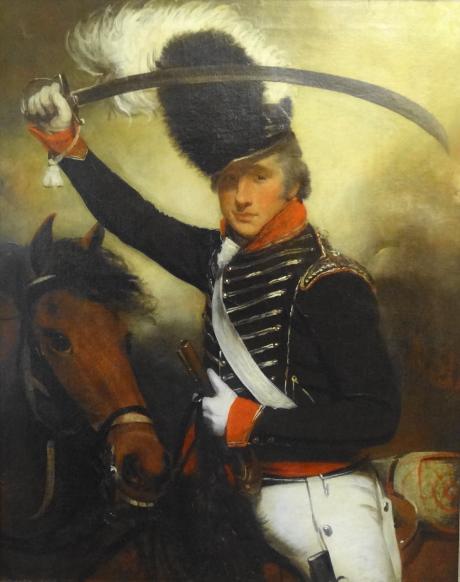Engraved by G Clint after Harry Ashby and John Nost Sartorius, published by Robert Ashby, 29th feb 1804, the engraving was iscribed "Diamond in the possession of Robert Ashby / painted by Sartorius / "To Sir Charles Price Bart, MP / late Lord Mayor of London / Portrait of a non commissioned officer of the London Volunteer Cavalry.
The portrait is painted by Harry Ashby and depicts his brother Robert Ashby who was a non commissioned officer of the London Volunteer Cavalry and Flying Artillery, he was one of many middle class /artisan types who filled the ranks of volunteer corps such as this. Robert was also a painter but concerned himself mainly with running the family engraving business with his father. A more substantial engraving featuring Robert as the main focus was published by the Ashby firm and dedicated to Sir Charles Price Bt , MP (1747-1818 ) to commemorate his term as Lord Mayor of London 1803 - 1804. Sir Charles Price was Colonel of the London Volunteer Cavalry and an eminent banker. The engraving features Robert Ashby mounted on his charger "Diamond", the horse was painted by John Nost Sartorius 1759-1828 for the original painting of the engraving. It is likely that Ashby brought in the more accomplished equestrian artist to paint the main horse and horses in the background for the larger painting. It is likely that the engraving which depicts military manouvers by the Volunteers was not only to commemorate Sir Charles Price's new elevated position but to also serve as a patriotic "rally the troops" sort of scene, in the face of the impending French invasion threat. The engraving is inscribed as follows "Diamond a charger in the possession of Robert Ashby painted by Sartorius To Sir Charles Price. Bart. MP. Late Lord Mayor of the City of London This portrait of a noncommissioned officer of the London Volunteer Cavalry is by permission most respectfully dedicated by his loyal and faithful servant Robert Ashby engraved by George Clint published by Robert Ashby 29th feb 1804." The sword is the 1796 Pattern Light Cavalry sabre so the picture would date between 1796-1812
Ashby, Harry (bap. 1744, d. 1818), engraver, was baptized Harry on 8 April 1744 at Wotton under Edge, Gloucestershire, the second son of Robert Ashbee (c.1716–c.1799) and his wife, Sarah, née Gardiner (b. c.1715). Ashby was originally apprenticed to a Wotton clockmaker who also engraved dial-plates, spoons, and tankards. As he showed unusual aptitude for writing engraving, he subsequently worked (probably as a continuing apprentice) for Thomas Jefferys, geographer, of Charing Cross, engraving titles for maps. Later he worked for Jefferys's former apprentice, John Spilsbury, writing-engraver and inventor of the jigsaw puzzle, at 30 Russell Court, Drury Lane. Spilsbury died in 1769, and about 1772 Ashby married his widow, Sarah Spilsbury, née May (1732–1802). Their sons Robert and Harry were born in 1774 and 1778. Ashby took over the engraving business, disposing of the jigsaw section. By 1785, when Ashby joined the Musicians' Company, he had moved with his family to 83 Holborn Bridge, and by 1788 to 5 King Street, Cheapside, where he was in partnership with his son Robert. Apart from engraving maps (including London, Bath, and the Isle of Man), Ashby's main employment was engraving notes for the emerging banks at home and abroad. In this he showed unusual skill and ingenuity, and many of his bank notes and plates are now at the British Museum, London. He also excelled as an engraver of specimens of calligraphy. He engraved the plates for Richard Langford's Beauties of Penmanship (1785), John Hodgkin's Specimens of Greek Penmanship (1804), and H. Genery's Geographical and Commercial Copies (1805), now at the British Library, also Hodgkin's Calligraphia Graeca (1794), William Milns's The Penman's Repository (1795), and some plates in Thomas Tomkins's Beauties of Writing (1777 and 1808), now at the National Art Library. On 16 April 1805 Ashby married, second, Phoebe Everett, at St Matthew's, Bethnal Green. Harry Ashby lived in retirement at Exning, Suffolk, where he died on 31 August 1818. He is buried in Exning churchyard. Robert Ashby and his sons ran the engraving business after his father's retirement. The firm continued as Ashby & Co. until 1886, but Robert died in obscurity in Hanley, Staffordshire, in 1843. Ashby's second son, Harry Ashby (1778–1847), a portrait artist, exhibited sixty-nine pictures at the Royal Academy. His son, Harry Pollard Ashby (b. 1808), exhibited twenty landscape paintings there.
Thompson Cooper, rev. Colin J. S. Davies DNB



